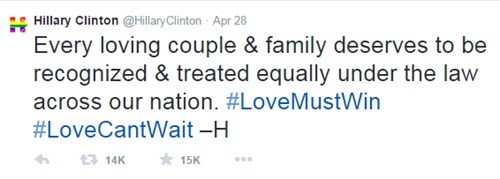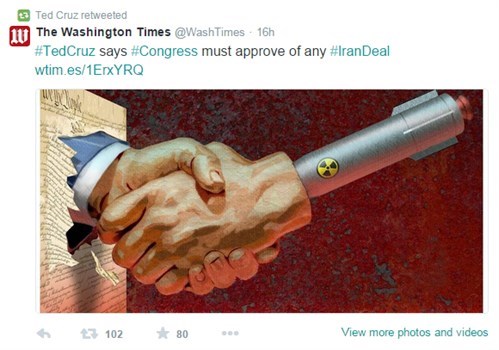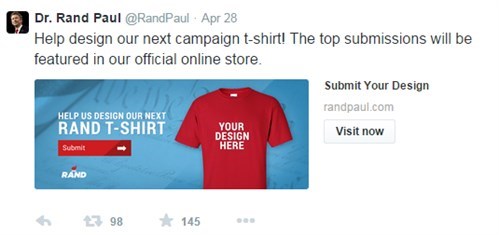Lessons for Hillary
11 May 2017
The US election cycle is heating up just as the UK election cycle draws to a close. Campaigning in the 2015 General Election is reaching a crescendo, so we’ve been assessing just how effective social media has been from the major parties (and individuals) ahead of May 7th.
This gives us an excellent opportunity to look at the patterns in social media around UK campaigns and assess whether they can be used to make predictions for the Presidential runs in the US. It is being predicted that the UK election will be the tightest general election that we’ve seen in decades, and there may be a dead heat between Labour and the Conservatives.
Here are a few of our observations about the political soup being stirred up on Twitter.
Personality Politics
If we look at the number of Twitter followers of the three main parties* and their respective leaders, we’re left with no doubt that personality rules. Social media is about views, opinions and sometimes arguments (which marries up nicely with politics) – and they’re much easier to digest and engage with when they come from an individual. Every major candidate in the UK achieved at least double the number of followers compared with their parties. This underscores the need for relatability, personality, and approachability in the public persona of the candidates.
Conservatives
- The Conservatives have 153,841 followers
- David Cameron has 986,520
Labour
- The Labour Party has 206,229 followers
- Ed Miliband has 453,265
Liberal Democrats
- The Liberal Democrats have 93,066 followers
- Nick Clegg has 234,805
*Other political parties are available
When David Cameron refused a one-on-one debate with Ed Miliband, Twitter exploded with chatter around accusations that Cameron was running scared. This was the most tweeted moment of the BBC election debate, with 8,652 tweets per minute. In addition to further spreading a specific message from or about a candidate, this 'sentiment analysis' is also used by campaign teams as a measure of resonant messaging.
As of today, hopefuls in the US are still announcing their candidacy, so we can only look at the early contenders:
Democrats
- The US Democratic Party has only 10% of Hilary’s followers, with 376,000.
- Hilary Clinton has amassed 3.45M Twitter followers with a mere 261 tweets.
Republicans
- The Republican Party has 341,000
- Ted Cruz has 403,000 followers.
- Rand Paul has 608,000 followers
Before you draw conclusions about a candidate’s viability based on Twitter followers, keep in mind that accusations have already started flying about fake followers. And of course, community size is only one part of the social media equation as biggest doesn’t always mean best. What about the content strategy?
Old School Broadcasting
A quick précis of the content strategy of the main parties and leaders produces a rather sad story for this social media strategist. I was hoping for lots of engagement - something to clearly direct me to a party’s view on a topic, and perhaps a touch of personality. Alas, what I see is exactly what we advise our clients to avoid – using social media as an old school broadcasting platform with little expression of honest debate or engagement.
Of the six Twitter accounts highlighted above, only Nick Clegg has replied to tweets. The other accounts are a mix of broadcasting and RTs of party/leader content. The overwhelming lack of candidate/party engagement not only feels dry and lifeless, as evidenced by the low number of RTs/Favs, it clearly isn’t resonating with their audience. We’re not advocating responding to every comment or question, but there’s a missed opportunity for party leaders (and their social media teams) to connect with voters in a less robotic and more human way.
So let’s look at trends with the US presidential candidates:
Hillary Clinton:
Hillary’s team is on a mission to improve her perceived approachability and personality. The Clinton Twitter feed frequently uses inclusive language and provides anecdotes that name voters. Still, there are no replies from 'Team Hillary' and the feed is peppered with calendared talking points. A highlight of the Clinton twitter feed is that Hillary notates the tweets that she has personally published.



Ted Cruz:
Cruz uses Twitter almost exclusively to broadcast talking points. The content exposes a calendaring tactic with little attention to real-time opportunities or social listening. Cruz has presented himself as an everyman, and his team is overlooking the impact that Twitter content can have on how he is seen as an individual. In his case, the Twitter strategy is actually a counterpoint to his on-camera persona, which seems like a questionable strategy.

Rand Paul:
Paul reliably posts general messages of thanks to the constituents as a group, but rarely calls out individuals unless they are donors. His approach is generally inclusive, but rarely personal:



Negative Campaigning
It’s fair to say that the agendas in the UK election campaign have been guided by negative campaigning, which doesn’t resonate well on social media. Our data shows that people share (and like to be associated with) positive messaging. It raises a real question around campaign messaging for different media platforms – while negative campaigning may be beneficial in a TV studio debate with an opposing candidate it does not necessarily mean that the same campaign method translates to Twitter in an equally or more effective way.
If UK politicians had been taking lessons from the last US election cycle, they would have seen reports published post-election in 2012 confirming that while traditional negative advertisements can sway voter opinion without damaging the advertising candidate’s reputation, it doesn’t work out so well on social media, where negative content creates or adds to the perception that the individual candidate has a nasty streak.
Even candidates who choose to take a strongly negative approach to taking out their competition would be advised to mellow out on social media, where a little negativity goes a long way.
Boosting Profile
And while the main parties in the UK have focused on attacking each other, we find other party leaders using social media effectively to build on their growing profile. Nicola Sturgeon, Leader of the Scottish National Party, has received significant positive coverage following live TV debates which has been enhanced further with an informative and entertaining social presence. This typical exchange with a journalist offers up something of the personality behind the Twitter account:
Digital door-to-door campaigning
The leaflet drop is still king when it comes to candidates connecting with their local community in the UK. In my own constituency I’m seeing an increase in social media activity from candidates who are happy to engage with prospective voters, but there seems little strategic thinking behind the content. With around2,375 of the 3,849 candidates active on Twitter it’s an area I expect to evolve greatly before the next election with top-level party social media teams taking an increased role in connecting with local voters.
US politicians could see easy wins at local level with paid social media campaigns on specific community issues to help win votes. The localization and demographic profile data on Facebook and other social channels are a win for politicians who want to demonstrate interest about local issues, which drive votes in the US.
If you’ve got a question about the 2015 General Election you might want to tweet your local candidates via this handy BBC list.
And we’re not sure if they will take us up on it, but US candidates are welcome to ring us up if they’d like some advice.

